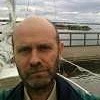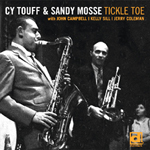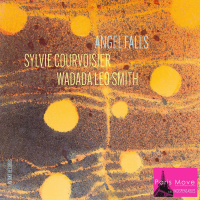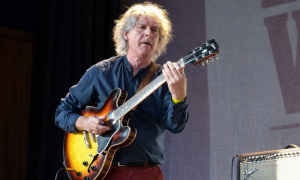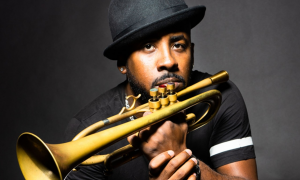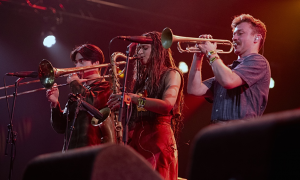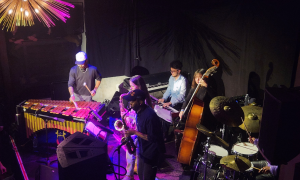Home » Jazz Articles » Live Review » Kongsberg Jazzfestival: Music from the Hall of the Mountain King
Kongsberg Jazzfestival: Music from the Hall of the Mountain King
Norway
July 2-5, 2008
Ever since David Lindley's The Sweet Sunny North reached distant shores in the early 1990s, Norway has been on many musical radar screens. Maybe it is impossible to think of the country without the fjords and the fells, so let's get them done and dusted. A country of five million people, 25% of which is forested and over 70% empty, leaves a lot of space to spare—for individuals, animals and jazz aficionados. Go there in the winter and undoubtedly there is plenty of inspirational bitter cold, and no doubt like in other Nordic countries, much of the country hard at work, keeping proverbial wolves from doors.

But now it's the height of the summer season, and when the sun shines there it glares from skies made bluer by the green hills rising on all side. And of course it shines almost around the clock. People respond by casting hard work aside, and devoting themselves to partying, or more particularly festivalling.
Of Scandinavian jazz festivals Kongsberg is the second oldest and one of the largest with around 30,000 ticket sales this year according to director Tor Dalaker Lund. The range of artists at a festival of this size is impressive too. This summer the Norwegian roster covered the range from pop and big band, combined in singer Sonje Lerche with the band of the Norwegian Navy, to the roughest of volume jazz in the form of Swede Mats Gustaffson and The Thing. International artists were also represented by a broad spectrum including 'aging punk violinist' from the UK Nigel Kennedy, Wayne Shorter playing with Imani Wind of New York, and USA's own Tierney Sutton. The music was invariably of the highest quality, played in venues of exceptional attractiveness (including a refurbished silver smelting factory and a quaint local tea-room), appealing to an audience as diverse as the fare.
Add to this the accompaniment of immaculate weather and you have the recipe for a stellar festival experience! Indeed, walking between the 18 different sites is frequently a pleasure, not the least due to their separation by 70 metre bridge across a raging torrent of Grade 5 white water. The air shimmers with positive ions and one's ears sing with the roar of the water. To the spread of streetside fashion and craft shops were added the usual set of handicraft and accessories stalls, Asian food booths as well as traditional Norwegian hotdog stands. Even the portable toilets, lined up along the kerbside at one point, fail to diminish the air of quality that pervades this quiet town during festival week.
Here follows short reviews of those acts that I found time to sample from Days 1 to 4, July 2—6, as well as comments on those that I managed to miss.
Day 1 - Wednesday, July 2
The first luxurious afternoon I found myself in the dungeon like hall of 'The Smelting Room' where Dans les Arbres, an assemblage of Norwegian players with a French clarinettist Xavier Charles, wooed the audience with a near ambient experience of dream-like acoustic music. The band comprises Ingar Zach on percussion (a horizontally mounted bass drum attacked from all angles and with all manner of implements), Ivar Grydeland playing acoustic banjo and guitar (although pizzicatoing would be more accurate), and renowned keyboardist Christain Wallumrod a very dampened, minimalistic piano as well as occasional finger harp. These three are led by Charles, whose equally muted playing and often staccato phrases mesh seamlessly with the mellow timbres of his fellow members, though at times seeming rather distanced from them. In the darkness of the long stone-walled room, the effect of the two extended pieces was mesmeric. Despite the quality of the sound suffering from the room's unfriendly acoustics, I drifted between conscious presence of the room and far, distant places.

Also appearing that evening drawing positive comment were the Pettre Wettre Quartet playing a number of his own 'catchy tunes' with the Norwegian Radio Orchestra. The band features Erlend Slettevoll on piano, the Dane Jonas Westergaard on bass and Anders Mogensen on drums, going down well as festival opener on the main stage. By contrast in the small Energy Mill the first of the festival's Smalltown Superjazz label's evenings kicked off. This featured the ferocious The Fat is Gone, with Messrs Gustafsson, Brotzmann and Nilssen-Love, probably the three most extreme Scandinavian free-jazzers currently active, laying down the guidelines for what was to include a wealth of sweaty musical evenings in this steamy, 100-seat, power generation workshop.
Day 2—Thursday, July 3
Mats Gustaffson is known for his ability to shred ears and other anatomical extremities with his coruscating baritone saxophony. However this show started with the man hunched over a table on which rested 3 innocuous electronic boxes. Needless to say they proved to be some kind of voltage regulating sound generators, whose gentle washes and blips soon gave way to the kind of visceral grunts and guffaws that are his normal acoustic trademark. The escalated howling and pounding gave way to a more sublime washes and a final zap, to close this part of the program. It also made a thoroughly natural link between the electronic half of his show and the second acoustic part, which was a typical display of his full-blooded exploration of tone and timbre of his solo saxophone through one extended piece.
The subsequent set from Free Fall, with members Kenneth Vandermark's on Bb and bass clarinet with pianist Havard Wiik and bassist Ingebrigt Haker-Flaten, continued this experimental theme. Vandermark leads from the front: tall, solemn and rather portentous, but behind him Haker-Flaten works like a beaver on all ends of his instrument. Wiik to the side plays very fluent piano, intermediating between the others both rhythmically and melodically. The program continued in a similar astringent vein with the duo of Nilsen-Love and Joe McPhee.
The evening saw the conclusion of the Smalltown Superjazz programme, first with 75 minutes of hyper-active musicality from The Thing, continuing through till the early morning with Original Silence. The former saw Mats Gustaffson sparring with Kenneth Vandermark out front, while behind Nilssen-Love and Flaten kept up their intense rhythmic work, taking listeners on an interstellar investigation of the outer reaches on saxophone-led hyper jazz. Original Silence added guitar (from Terri Ex and Casper Brotzmann) and bass (Massimo Pupillo) to Gustaffson and Nilssen-Love's presence, bringing down the curtain on the oft anarchic sounds and energies emanating from this dynamic, young Oslo-based label.

The same evening saw similar angular, complex music from Diamond Curtain Wall, where Anthony Braxton was joined by Taylor Ho Bynum on trumpets and like horns, and Mary Halvorson on guitar. This must have been interesting, as it provoked much breakfast table discussion. Similarly that evening saw performances from the Nigel Kennedy Quintet, in which the ever-youthful violinist is accompanied by electric cello, guitar and rhythm section, playing a selection of his own tunes. Saxophone Summit, with Joe Lovano, Dave Liebman and Ravi Coltrane also filled the main stage that same evening, though without fueling excessive debate the following morning! Roy Hargrove's animated performance with his Quintet in the town cinema was another classy performance of straight-on jazz from another seasoned act.
Day 3—Friday, July 4
Another stellar day with a table-full of classic jazz and plenty of appetizing side dishes too. My starter was a bizarre combination of meandering female vocals and the pounding toms of Wildbirds and Peacedrums. This duo from Gotenburg, Sweden, has won the Jazz in Sweden prize in 2008 and offered a selection of hypnotic songs from Mariam Wallentin, accompanying herself on organ, snare or simply a waved drumstick, and by Andreas Werlin's relentless rhythms. Described as part pop, part improvisation, and part tribalism, it was an intriguing mix, somewhere between Joni Mitchell and John Bonham, maybe best appreciated by members of their children's generation.

The afternoon featured a nice set from Ingrid Mjanger and Paul Holden, themselves half of Bergen's own Orphelia Hope. Another winner of a jazz prize herself (this one in Norway in 2006), Mjanger here revealed the determinedly wistful side of her repertoire, mainly composed by her guitar accompanist Holden. Songs of lost love, lonely hills and ceaseless waves were a delicate taste of nicely crafted work.
For classic connoisseurs there were two major concerts on this day—an early evening combination of Wayne Shorter playing with the classical New York female reed ensemble Imani Winds. Following a short set of 2 breezy compositions by band members and one by Astor Piazolla, they left the stage for the Wayne Shorter Quartet. The veteran musician produced a 40 minute show with Messrs Perez, Patitucci and Blade on fine form. The final set included both ensembles squeezed on stage, which lead to a cluster of bursting energy from Blade and his bandmates, which visibly raised some hairs amongst the classical sorority. The other major occasion was an evening with Miles Davis' bassist and Shorter's former colleague Ron Carter, with his own band playing a catalogue of their former leader's tunes. A highly polished affair by all accounts.
Among other features remaining unsampled that day were a major concert featuring Norwegian pop star Sondre Lerche with the Norwegian Navy Big Band, two more left field energy acts (an all-star Nordic line-up of Nilssen-Love, Frederk Ljungkvist and Jonases Kullhammar and Westergaard, and the Norwegian death-jazz act Bushman's Revenge) as well as Danish trumpeter Stefan Pasborg with his Odessa 5. However one other essential feature of a broadly based festival did find its way into my program—the children's show. Billed as Casiokids I had expected a nifty balance of digital absurdity with some good child-centered fun. It turned out to be less cutting-edge than expected, with a guitar/drum/bass line up and more of a Teletubbies repertoire. But the intended audience reveled in the fun, so who am I to criticize?
Day 4—Saturday, July 5
The final festival day dawned again brightly, and the program itself shone with some memorable jewels. As well as a selection of jazz films (Oscar Peterson in Montreux 1975 and Monk's Straight—No Chaser), some had to be ignored, like Markus Strickland playing with local boy made good Lage Lund, and an evening with Wisconsin's own Tierney Sutton.
Instead I found my full share of left field fun, in the form of 2 outdoor avant-garde acts and a sweltering sound bomb in a quaint tea room! The first show involved Belgian bassist (sculptor and painter) Peter Jacquemyn with Swiss violist Charlotte Hug performing to each other and an audience crammed in a Beijing-style inner courtyard. The music involved much exploration of dynamics of their respective instruments, which occasionally duplicated each other at different ends of the string spectrum, though like much acoustic improvisational work seemed sometimes to resemble performance art or street theatre. They were followed by a Dutch guitarist and a French clarinetist, who actually ended their set almost falling into each other's arms in laughter! Terrie Ex (of veteran Dutch punk band The Ex) and Dans les Arbres's lead instrumentalist enjoyed their efforts to entertain—and the music was fun too!

For many the final day's program was crowned by a late night church-based acoustic concert involving Johannes Martens and 4 colleagues playing both his own and some of their own compositions, and resulting in more discussion breakfast discussion. For some this was topped by the much-heralded concert of young, critically acclaimed Norwegian trumpeter, Mathias Eick. This was a very interesting outing by a talented young quartet, opening with some wistful trumpet-led romances and developing into some serious funky extemporization between pianist Andreas Ulvo, bassist Nicolai Eilertsen and drummer Audun Kleive. Very listenable, especially the dueling between Eick's tablas and Ulvo's Fender Rhodes, but rather reminiscent of guitar-led progressive jazz-rock, with that role appropriated by the trumpet.
The jewel in the crown for me had to be a 90 minute set of ear-bending improvisational exploration from Norway's Supersilent. Although nearly 10 years and 7 CDs along the road, the band has had limited exposure outside its home country, and given the genre of their music it will surely stay that way.
 The music is highly electronic with only one of its members not usually producing a synthesized sound—and that's the drummer. No surprise that an essential element is the use and abuse of rhythm. The band's approach nowadays is totally improvisational, foregoing any rehearsals and even eschewing discussion of their collaborations. Telepathic communication skills must by now be well honed as the band members trade tones and timbres in a helter-skelter of pinball table cacophony. If British critic Julie Birchill had been present she would surely have reasserted that this was 'a whole pile of notes in search of a melody,' but maybe would also have admitted that melody is often very close to the surface. Trumpeter (vocalist and electronic percussionist) Arve Henriksen and keyboardist Stale Storlokken often took the lead in intimating a melodic line that would then disappear in the welter of crossbeats and barely constrained furor.
The music is highly electronic with only one of its members not usually producing a synthesized sound—and that's the drummer. No surprise that an essential element is the use and abuse of rhythm. The band's approach nowadays is totally improvisational, foregoing any rehearsals and even eschewing discussion of their collaborations. Telepathic communication skills must by now be well honed as the band members trade tones and timbres in a helter-skelter of pinball table cacophony. If British critic Julie Birchill had been present she would surely have reasserted that this was 'a whole pile of notes in search of a melody,' but maybe would also have admitted that melody is often very close to the surface. Trumpeter (vocalist and electronic percussionist) Arve Henriksen and keyboardist Stale Storlokken often took the lead in intimating a melodic line that would then disappear in the welter of crossbeats and barely constrained furor.
This was an ear-splitting affair, many in the audience holding onto their ears for protection, but hanging on to every blip and burp from those boxes. To me it brought back the frenetic wall of analogue sound that Pink Floyd would use in their early days of extreme experimentation. I wondered how Syd Barrett would have felt about these contemporary developments 40 years after he had first heard similar abstract music from AMM in a London concert. There were many of his generation in the concert, but equally as many from later ones. Indeed this concert reflected the success which Kongsberg can pride itself in achieving, catering for the broadest spectrum of modern musical tastes, while championing those at the edge. The cosy respectability of the tea-room contrasted with the cutting edge modernity of these performers. And it all seemed to prove that Kongsberg Jazz is one of the places globally to witness this edge of modern jazz slowly move forward, whether you measure it in inches or in centimeters.
Photo Credit
Opening Day / Main Stage by Thomas Reisaeter
Day 2, The Thing and Anthony Braxton by Stein Hofve
Day 3, Wildbirds and Peacedrums by Stein Hofre
Day 4,Supersilent by Thomas Vaag
Tags
PREVIOUS / NEXT
Support All About Jazz
 All About Jazz has been a pillar of jazz since 1995, championing it as an art form and, more importantly, supporting the musicians who make it. Our enduring commitment has made "AAJ" one of the most culturally important websites of its kind, read by hundreds of thousands of fans, musicians and industry figures every month.
All About Jazz has been a pillar of jazz since 1995, championing it as an art form and, more importantly, supporting the musicians who make it. Our enduring commitment has made "AAJ" one of the most culturally important websites of its kind, read by hundreds of thousands of fans, musicians and industry figures every month.

